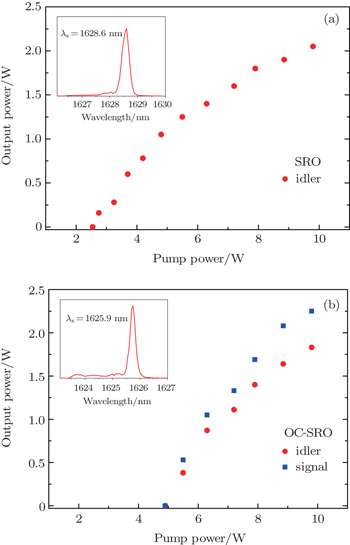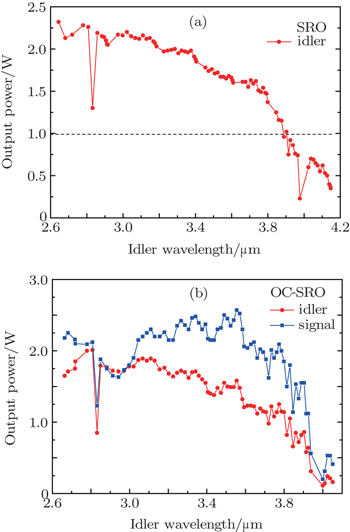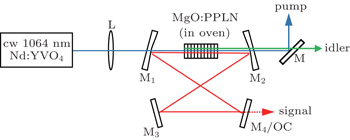† Corresponding author. E-mail:
‡ Corresponding author. E-mail:
Project supported by the National Natural Science Foundation of China (Grant Nos. 61308056, 11204044, 11232015, and 11072271), the Research Fund for the Doctoral Program of Higher Education of China (Grant Nos. 20120171110005 and 20130171130003), the Fundamental Research Funds for the Central Universities of China (Grant No. 14lgpy07), and the Opening Project of Science and Technology on Reliability Physics and Application Technology of Electronic Component Laboratory, China (Grant No. ZHD201203).
We present a continuous-wave singly-resonant optical parametric oscillator with 1.5% output coupling of the resonant signal wave, based on an angle-polished MgO-doped periodically poled lithium niobate (MgO:PPLN), pumped by a commercial Nd:YVO 4 laser at 1064 nm. The output-coupled optical parametric oscillator delivers a maximum total output power of 4.19 W with 42.8% extraction efficiency, across a tuning range of 1717 nm in the near- and mid-infrared region. This indicates improvements of 1.87 W in output power, 19.1% in extraction efficiency and 213 nm in tuning range extension in comparison with the optical parametric oscillator with no output coupling, while at the expense of increasing the oscillation threshold by a factor of ∼ 2. Moreover, it is confirmed that the finite output coupling also contributes to the reduction of the thermal effects in crystal.
High-power, continuous-wave (cw) optical parametric oscillators (OPOs) are excellent coherent light sources for various applications including trace gas detection, [ 1 , 2 ] high-resolution molecular spectroscopy [ 3 , 4 ] and optical radiometry, [ 5 ] which require a combination of high spectral resolution and broadband wavelength tunability in the important infrared (IR) spectral region of 1–4 μm wavelength. Although doubly and triply resonant OPOs can be operated with lower pump threshold (1–100 mW), singly resonant OPOs (SROs) have been more widely used as infrared sources because of their advantageous conversion efficiency, stability and tuning properties.
With the development of periodically poled crystals as parametric materials and high power diode-pumped solid-state laser (DPSSL) or fiber laser as pump sources, various cw SROs with high performance in efficiency, stability, tunability and other characteristics have been demonstrated. [ 6 – 8 ] In a typical SRO, the cavity loss of the resonant signal wave is considered to be as low as possible to minimize the threshold, while maximum output coupling for the non-resonant idler wave is provided to ensure the singly resonating and achieve highest power extraction. In these cases, however, the signal wave is inaccessible. To extract the resonant signal wave, with nonlinear crystals such as PPLN that possesses a large effective nonlinear coefficient, conditions can be somewhat relaxed and finitely coupling out the signal is tolerated. [ 9 , 10 ] Recently, Li et al . obtained 6.2 W of signal at 1.56 μm at an extraction efficiency of 42.8% from a double-pass-pumping SRO by employing a 2.5% output coupler. [ 11 ] The finite output coupling of the resonant signal wave not only increases the extraction efficiency in the near-IR, but also greatly reduces the intracavity intensity, and hence the thermal effects.
Here, we portray a cw SRO with finite signal output coupling, and a typical cw SRO with no output coupling for comparison. Both of them are based on an angle-polished MgO:PPLN in a four-mirror unidirectional ring cavity, providing high conversion efficiency and wide tunability in the near- and mid-IR. Performances of both configurations with regards to oscillation threshold, idler and signal output power, extraction efficiency, and useful tuning range are presented. A comparative analysis of the thermal effects in the MgO:PPLN crystal induced by the absorption of the intense resonant signal wave is also performed.
As depicted in Fig.
We investigate the power scaling of both configurations for comparison. The measurements are performed at a crystal temperature of 90 °C for the same grating period ( Λ = 31.0 μm). For the SRO, as shown in Fig.
 | Fig. 2. Curves of extracted power versus pump power at Λ =31.0 μm, T = 90 °C for MgO:PPLN in SRO (a) and OC-SRO (b). |
Given the threshold of 2.6 W in SRO, the sum of all residual losses for the signal wavelength inside the cavity is estimated to be 1.8% according to Ref. [ 13 ]. On the other hand, the threshold of the OC-SRO is 4.9 W. Taking the output coupling loss as 1.5%, the sum of all residual losses is estimated to be 1.9%, which is almost the same as the one in SRO. This is reasonable since the only difference between the two configurations lies in the output coupler. Such a high residual loss for the signal wave is believed to stem from the imperfect coating of the cavity mirrors and crystal end faces, and the crystal absorption as well. The signal wavelength is measured to be 1628.6 nm and 1625.9 nm in the SRO and OC-SRO (shown in the insert of Fig.
Broadband tunability is available in both configurations by taking advantage of the multi-period PPLN together with a temperature-controlled oven. By changing the grating period in steps of 0.5 μm, coarse wavelength tuning can be obtained; fine tuning can be achieved by scanning the temperature of the PPLN in small steps. According to the theoretical tuning curves calculated from the Sellmeier equations, [ 14 ] when the crystal temperature changes from 30 °C to 170 °C, the tuning ranges of the different grating periods overlap. Therefore, continuous wavelength tuning of the output idler in the mid-IR region can be achieved. Figure
 | Fig. 3. Extracted power across the tuning range at a maximum pump power of 9.8 W for (a) SRO, (b) OC-SRO. |
In the OC-SRO, output powers of extracted idler wave over the tuning range together with the corresponding signal wave are characterized in Fig.
It is worth noting that in the SRO configuration, due to the absence of signal output coupling, and hence the critical thermal loading in the crystal, stable operation is unavailable below 35 °C. In contrast, room-temperature operation at 30 °C is possible in OC-SRO configuration, which means that the deployment of output coupling can extend the tuning range of a single period. However, in the case when the OC-SRO is tuned above 4 μm ( Λ = 28.5 μm, T < 120 °C), the 1.5% output coupling loss together with the substantial residual loss leads to an unacceptable rise in threshold, rendering OC-SRO operation beyond the reach of our pump source. This accounts for the decreasing of the idler tuning range in OC-SRO. Therefore, an optimal output coupling is desirable, being a trade-off between the extraction power and the rise in threshold. As theoretically predicted, a maximum conversion efficiency is achieved for pumping at ( π /2) 2 times of the oscillation threshold, [ 15 , 16 ] confirming that an output coupling of 1.5% is not optimal for our device and higher output powers in OC-SRO can be expected.
In this work, we demonstrate that the OC-SRO configuration shows significant enhancements in extraction efficiency and useful tuning range over SRO with no output coupling, especially in the near-IR region. With finite output coupling of the resonant signal wave, substantial signal power tunable in a wide near-IR region is available for additional applications such as cascaded pumping of mid-IR OPOs, at the expense of increasing the oscillation threshold and slightly decreasing the idler power. In addition, the output coupling also contributes to the reduction of thermal effects in crystal and thus is promising for high-power cw OPOs. Further improvement will be focused on optimizing the output coupling across the tuning range so that higher extracted powers and efficiencies are expected.
| 1 | |
| 2 | |
| 3 | |
| 4 | |
| 5 | |
| 6 | |
| 7 | |
| 8 | |
| 9 | |
| 10 | |
| 11 | |
| 12 | |
| 13 | |
| 14 | |
| 15 | |
| 16 |



